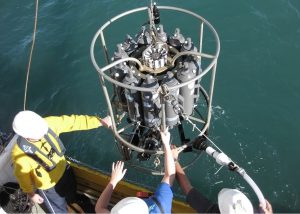Study Identifies Potential Oil Degradation Signal in Coastal Waters
– June 13, 2014
Scientists from Texas, Delaware, and Louisiana conducted a multiyear study examining coastal waters in the Gulf of Mexico to determine if hydrocarbons from the Deepwater Horizon oil spill had changed the water column chemistry.
During this process, they found that monitoring levels of apparent oxygen utilization (AOU) and dissolved inorganic carbon (DIC) in bottom waters could be a means for detecting the presence and/or degradation of hydrocarbons following an oil spill. The researchers published their study in the January 2014 online issue of Deep Sea Research Part II: Topical Studies in Oceanography: Coupled oxygen and dissolved inorganic carbon dynamics in coastal ocean and its use as a potential indicator for detecting water column oil degradation.
Marine microorganisms play critical roles in ecosystems by carrying out many biogeochemical processes such as contributing to primary productivity, regulating water quality, and degrading contaminants. The “Redfield ratio” of a water column refers to a specific ratio (or stoichiometry) of carbon, nitrogen, and phosphorus release during organic matter remineralization. Analyzing the relationship between AOU (a parameter that defines the extent of oxygen consumption by microorganisms) and DIC (CO2 release from the same microbial respiration that consumes oxygen) and comparing their alignment with the Redfield ratio can indicate the type of organic matter that is transforming into CO2.
Prior research that examined organic matter remineralization stoichiometry often focused on open-ocean, subsurface, and deep waters in which “water mass compositions are relatively simple and air-sea gas exchange is nil.” Previous studies of coastal areas, however, “tend not to use the observed AOU-DIC relationship to obtain quantitative information” because of “the potential complexity in water column hydrodynamics (e.g., mixing with either freshwater or among different coastal water masses) and gas exchange between the atmosphere and the ocean.” This study assesses the relationship of AOU-DIC in coastal water chemistry using pre- and post-oil-spill samples and offers new insight to identify oil degradation.
The team collected water samples from 2006 to 2012 in depths up to 200 meters from areas near the shoreline to those in the vicinity of the shelf-slope break. For this study, researchers used only the samples collected 1 – 2 meters above the sea bed in water from 20 to 50 meters deep to limit freshwater influence.
While most AOU and DIC data were consistent with the Redfield ratio, four samples taken in July 2010 revealed a “significant deviation” in the relationship between AOU and DIC in waters collected between the Southwest Pass of the Mississippi River and Terrebonne Bay. Follow-up studies in July of both 2011 and 2012 showed that the water column chemistry had returned to pre-spill conditions.
The team concluded that “petroleum carbon degradation from the Deepwater Horizon oil spill may have influenced four stations in the Louisiana Bight” in July 2010 based on “the coevolution of bottom water oxygen and dissolved inorganic carbon and the deviation of AOU–DIC relationship.” By July 2011, observations suggested that the area was “likely free from oil” originating from this spill. While acknowledging that they could not be certain of the exact type of carbon being used by bottom water microbes, the team felt that “monitoring of bottom-water DO and DIC indeed may provide a potentially useful tool for detecting degradation of petroleum carbon in the water column” and that “this approach could be used in deeper waters as well.”
The study’s authors are Xinping Hu, Wei-Jun Cai, Nancy N. Rabalais, and Jianhong Xue (Deep Sea Research II: Topical Studies in Oceanography, 2014: 1-8).
************
This research was made possible in part by a grant from the Gulf of Mexico Research Initiative (GoMRI) to the University of Delaware (click here for project information) and to the Coastal Waters Consortium (CWC). The National Oceanic and Atmospheric Administration (NOAA) provided funding for the 2010, 2011, and 2012 research cruises. NOAA Grant # NA09NOS4780204 from the Center for Sponsored Coastal Ocean Research.
GoMRI is a 10-year independent research program established to study the effect, and the potential associated impact, of hydrocarbon releases on the environment and public health, as well as to develop improved spill mitigation, oil detection, characterization and remediation technologies. An independent and academic 20-member Research Board makes the funding and research direction decisions to ensure the intellectual quality, effectiveness and academic independence of the GoMRI research. All research data, findings and publications will be made publicly available. The program was established through a $500 million financial commitment from BP. For more information, visit https://gulfresearchinitiative.org/.
© Copyright 2010- 2017 Gulf of Mexico Research Initiative (GoMRI) – All Rights Reserved. Redistribution is encouraged with acknowledgement to the Gulf of Mexico Research Initiative (GoMRI). Please credit images and/or videos as done in each article. Questions? Contact web-content editor Nilde “Maggie” Dannreuther, Northern Gulf Institute, Mississippi State University (maggied@ngi.msstate.edu).







